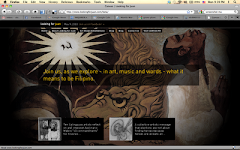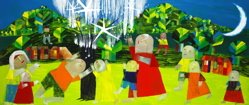Tuesday, November 28, 2006
A Makeover for the Santo Nino
 Images and icons.
Images and icons.Just came back from a short visit to Nepal and Thailand, and over there, it's Buddha. Over here, I suppose it's the Santo Nino (and jeepneys).
One key difference - Buddha seems to be making more money for Nepal and Thailand that the Santo Nino does for us. That's because Buddha - as pop art - is a bigger hit with the tourists, than the Holy Child. There's the laughing Buddha, the smiling Buddha, the reclining Buddha, the sleeping Buddha, even the sequined Buddha...
And because they're everywhere, attractive and easy to purchase, Buddha is not only a boon to their economy, the image also conveys a sense of the local culture that visitors can and do like to bring back home.
Friday, November 17, 2006
More on the Supposed Brain Drain
The Myth of the Brain Drain
For all their talk about free trade and globalization, they seem miss the point.
Just two things to think about:
1. It's not a zero sum game. Conrado de Quiros gets it in part when he says that we can now use information technology to bring the world to us. And in fact, the seeds of doing this are already being sown. GILAS and Last Mile Initiative-Philippines, are two of numerous efforts to provide all Filipinos with access to information and communications technologies.
 The key, however, is not just access. The key is actually using the technology for productive purposes. So when our more than 10 million bagong bayanis send their more than $10 billion back here every year, do we use them just to buy stuff or to make stuff? Do we use them to play games or to program games?
The key, however, is not just access. The key is actually using the technology for productive purposes. So when our more than 10 million bagong bayanis send their more than $10 billion back here every year, do we use them just to buy stuff or to make stuff? Do we use them to play games or to program games?There's nothing wrong when government proudly recognizes the role of OFWs, but government should remember that it's not there to clap. Government has to do more with the gift that OFWs give each year - and in simple terms, that's to equip and encourage those who stay to make productive use of this gift (through education and by making it easy to set up businesses)... and then get the hell out of the way.
2. And second, if other countries are taking away our brains, then why can't we take theirs? Sure, first world citizens may think twice about coming here, but it seems to me that a bright and educated Vietnamese or Indonesian or Indian or Chinese might just as easily give us ideas or capital or jobs...
We shouldn't be afraid of the competition they will bring to local folk... just as we're asking Americans not to be afraid of the nurses and teachers and virtual labor we send over there.
Come to think about it, maybe it's time we open the door to foreign coaches for our basketball (gasp!) and soccer programs. Vietnam and Thailand already are, and look how far their football programs are compared to us. Or look no further than Manny Pacquaio - he's got an American trainer - do you think he'd be the global phenomenon that he is now without him?
It's time for Juan de la Cruz to realize that it's a new world. In a globalized economy, there is no drain, there's just one big bathtub.
P.S. The painting is entitled "Technological Society" by Filipino artist Norman Dreo. A hopeful and positive representation of the ubiquituous role of information and technology in the Philippines today, Dreo won the Asean Art Awards (Juror's Choice) for this work a few years ago.
Wednesday, November 15, 2006
One Country... for a few rounds at least...
Tuesday, November 14, 2006
Culture in a Watering Hole
Still on shared collective experiences of a generation, have you ever visited The Watering Hole near Shangrila Mall along EDSA at 6:30 in the morning?
If you want to understand today’s youth, you could do worse than starting with a look at today’s call center culture.
Monday, November 13, 2006
The Jupiter Effect
 If you have the chance, read The Jupiter Effect by Katrina Tuvera.
If you have the chance, read The Jupiter Effect by Katrina Tuvera.For me, it’s fiction and yet it’s not, because everything in the story happens against the backdrop of events that profoundly shaped my, and most of my friends’ generation - Martial Law.
I remember my dad talking about his memories during the Japanese occupation when he was maybe 8 or 9 years old. Stories like how they didn’t know any better when they threw stones at trucks carrying captured Japanese soldiers at the end of the war. Or about how, during the occupation, his dad (my grandfather) would pound eggshells and mix it into their rice to give them more protein.
I don’t know how true it was that times were really that bad that eggshells had to be pounded and mixed into rice, or that doing so actually gave them more protein – but it didn’t really matter. It was a nice story that was just that. It wasn’t real enough for me and I couldn’t relate.
So now, when I now tell my kids about how, back in our days in the university, their mother and I once stood with hundreds of thousands of Filipinos in front of tanks to oust a dictator, or that we once marched from UP Diliman to Luneta, or that once upon a time it took less than 30 minutes to get from Makati to Quezon City, would they treat my stories the same way?
If we are defined in part by what we go through, what does that say about us as a people when most Filipinos probably can’t really relate to events that each of us may see as monumentally important? Some events, after all, simply have to be lived through to be truly real.
Sunday, November 12, 2006
A Start
 I stumbled into The Urban Forest Project.
I stumbled into The Urban Forest Project."The Urban Forest Project brings 185 banners created by the world’s most celebrated designers, artists, photographers and illustrators to New York’s Times Square. Each banner uses the form of the tree, or a metaphor for the tree, to make a powerful visual statement. Together they create a forest of thought-provoking images at one of the world’s busiest, most energetic, and emphatically urban intersections. Following their display, the banners will be recycled into tote bags and sold at auction, with proceeds going to scholarship and mentoring programs that benefit students of the visual arts. Some banners embody visceral responses to pressing environmental, political and social issues. Others use the evocative power of nature to develop rich patterns and abstract forms that delight the viewer. All contain passion, thought, and energy—qualities that only emerge when the world’s finest creative minds apply themselves to a brief they truly believe in."
It got me to thinking... can CANVAS do the same thing here in the Philippines?
One idea that has, for some time now, been percolating in my mind is to conceptualize a creative activity that explores what it means to be Filipino. Now that's a theme that seems to me to be more relevant, and more challenging.
So imagine it - an outdoor art exhibition featuring the works of 200 of the country's best artists, writers, graphic designers and photographers, showcased as banners, all conveying unique personal visual or literary representations of the contemporary Filipino. Imagine these banners lining public spaces that everyone can easily visit, reflect on or simply be proud of - like Luneta or the UP Academic Oval or Fort Bonifacio or Baywalk.
October 2008 sounds like a good target date for the big show. Between now and then, we're going to sell the idea to people, companies, and organizations that can help make this happen.
I'm not sure how or if I, and CANVAS, can make this happen. All we have right now is the passion and the idea. But we're certainly going to have fun trying.
So this blog will be as much about documenting this creative journey (I'm pretty sure the idea will still evolve over time), as it will be about finding the soul and heart of being Filipino.
Join us?






